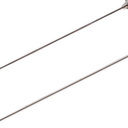Multiprobe fluorescence imaging and microspectrofluorimetry of cell transformation and differentiation: implications in terms of applied biochemistry and biotechnology.
Kulcsszavak
Absztrakt
The dichotomy of cellular transformation versus differentiation does not preclude the hypothesis of a unified underlying mechanism that can switch either way as a result of growth factors, cell-membrane receptors, secondary messengers, integrating switch kinases and/or nuclear receptors. Its study for biopharmaceutical and biotechnological applications requires a methodology capable of dealing with such pleiotropy. In the multiprobe-multiparameter approach, one must remain wary of cumulative toxic effects and misinterpretations. 'Smart' instrumentation does not mean 'smart' probes. It turns out that the cell's own endogenous probes, the fluorescent coenzymes, may be akin to 'smart' probes, open to study in situ of many-fold interrelated pathways in cell energetics and dynamics. Resolution at the micro- and even nano-compartment levels is not altogether impossible. Thus an innovative search in terms of what may be called 'intracellular reconnaissance with fluorescent probes and biopharmaceuticals' necessitates recourse to multiple tentative probings along the pleiotropic mechanisms as far in resolution as one can go. Among the characteristic findings using this approach are: (i) morphometric alterations in the mitochondria and melanosomes of melanoma cells treated with azelaic acid; (ii) deregulation of mitochondrial control and extramitochondrial metabolism in similarly treated cells; (iii) considerable acceleration of NAD(P) transient kinetics in atractylate-treated L sarcoma cells; (iv) alterations of mitochondria and Golgi in fusion-deficient myoblasts; (v) tentative recognition of beta-glucosidase deficiency in Gaucher disease cells by the use of fluorescent and fluorogenic lysosomal probes; and (vi) UVA-induced accumulation of Schiff bases (a kind of accelerated photo-aging) in yeast and kidney epithelial cells. Because these studies utilize probing at whatever points along the concerned pathways become accessible, at first glance they may look disconnected. What and where is the connecting thread, for instance, between studying melanoma metabolism, melanosome morphometry, hepatocyte organelle morphogenesis and transformation, myotube organelle morphogenesis and fusion-non-fusion, and lysosomal activity in gene-deficient cells? In the mapping of the regulatory and deregulatory mechanisms involved in the switching of differentiation or transformation, each of the above topics carries an information content towards resolution of the pleiotropic puzzle. The integration of such information with increasing resolution and access to intracellular microdomains may ultimately allow focus on the precise target, the switch from differentiation to transformation or vice versa.


